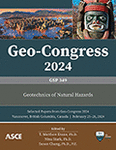High Strain Rate Effects on a Clayey Sand Mixture
Publication: Geo-Congress 2024
ABSTRACT
Understanding soil behavior under different strain rates is a key factor in many geotechnical applications, including earthquakes, dynamic compaction, rapid pile testing, roadway subgrade design, and projectile penetration. In this study, the stress-strain response of a clayey sand mixture at strain rates ranging from 0.0001/s to 10/s was studied. Remolded samples were prepared using a mixed soil consisting of 30% clay and 70% sand at a water content of 11%. This material is believed to represent materials commonly encountered in several formerly used defense sites that are in need of environmental remediation. The information is helpful for predicting the likely depth of burial of projectiles within the material to be remediated. Unconfined compression and unconsolidated undrained (UU) triaxial tests were conducted on 38-mm diameter cylindrical test specimens that were formed using previously hydrated mixed soils. The specimens were statically compacted at a constant rate of 1 mm/min. A hydraulic loading system equipped with an ultra-precise load cell and data acquisition system was used to capture load during tests. A strain rate logarithmic correlation was fitted to both unconfined and triaxial test results. Visual inspection of the test specimens suggests that rate dependence is due in part to changes in the failure mode. Test results can be implemented to account for the effect of strain rate in numerical simulation and analytical models.
Get full access to this article
View all available purchase options and get full access to this chapter.
REFERENCES
ASTM, D. 2016. 2166. Standard test method for unconfined compressive strength of cohesive soil. West Conshoshocken, PA, United States.
Biscontin, G., and J. M. Pestana. 2001. “Influence of Peripheral Velocity on Vane Shear Strength of an Artificial Clay.” Geotech. Test. J., 24 (4): 423–429. https://doi.org/10.1520/gtj11140j.
Carroll, W. F. 1988. “Fast Triaxial Shear Device.” Geotech. Test. J., 11 (4).
Casagrande, A., and S. D. Wilson. 1951. “Effect of rate of loading on the strength of clays and shales at constant water content.” Geotechnique, 2 (3): 251–263. Thomas Telford Ltd.
Casagrande, A., and W. L. Shannon. 1948. “Stress-deformation and strength characteristics of soils under dynamic loads.” Proc. 2nd ICSMFE, 29–34.
Chen, W. W., and B. Song. 2010. Split Hopkinson (Kolsky) bar: design, testing and applications. Springer Science & Business Media.
Farr, J. V, and R. D. Woods. 1988. “A device for evaluating one-dimensional compressive loading rate effects.” ASTM Geotech. Test. J., 11 (4).
Field, J. E., T. M. Walley, W. G. Proud, H. T. Goldrein, and C. R. Siviour. 2004. “Review of experimental techniques for high rate deformation and shock studies.” Int. J. Impact Eng., 30 (7): 725–775. Elsevier.
Huy, N. Q., A. F. Van Tol, and P. Hölscher. 2006. Laboratory investigation of the loading rate effects in sand. Delft Cluster.
Jackson, J. G., Jr., B. Rohani, and J. Q. Ehrgott. 1980. “Loading rate effects on compressibility of sand.” J. Geotech. Eng. Div., 106 (8): 839–852. American Society of Civil Engineers.
Omidvar, M., M. Iskander, and S. Bless. 2012. “Stress-strain behavior of sand at high strain rates.” Int. J. Impact Eng., 4https://doi.org/10.1016/j.ijimpeng.2012.03.004, 9: 192–213. Elsevier.
Reinhart, W. D., L. C. Chhabildas, T. J. Vogler, and J. L. Brown. 2007. Shock response of dry sand. Sandia National Laboratories (SNL), Albuquerque, NM, and Livermore, CA.
Sheahan, T. C., C. C. Ladd, and J. T. Germaine. 1996. “Rate-dependent undrained shear behavior of saturated clay.” J. Geotech. Eng., 122 (2): 99–108. American Society of Civil Engineers.
Whitman, R. V. 1970. “The response of soils to dynamic loadings.”. Massachusetts Inst of Tech Cambridge Dept of Civil Engineering.
Yamamuro, J. A., A. E. Abrantes, and P. V. Lade. 2011. “Effect of Strain Rate on the Stress-Strain Behavior of Sand.” J. Geotech. Geoenvironmental Eng., 137 (12): 1169–1178. https://doi.org/10.1061/(ASCE)GT.1943-5606.0000542.
Zhu, J.-G., and J.-H. Yin. 2000. “Strain-rate-dependent stress-strain behavior of overconsolidated Hong Kong marine clay.” Can. Geotech. J., 37 (6): 1272–1282. NRC Press, Canada.
Information & Authors
Information
Published In
History
Published online: Feb 22, 2024
ASCE Technical Topics:
- Clays
- Compacted soils
- Engineering fundamentals
- Foundation construction
- Foundations
- Geomechanics
- Geotechnical engineering
- Geotechnical investigation
- Laboratory tests
- Material mechanics
- Materials engineering
- Penetration tests
- Soil mechanics
- Soil mixing
- Soil properties
- Soil stress
- Soils (by type)
- Strain
- Strain rates
- Tests (by type)
- Triaxial tests
Authors
Metrics & Citations
Metrics
Citations
Download citation
If you have the appropriate software installed, you can download article citation data to the citation manager of your choice. Simply select your manager software from the list below and click Download.
